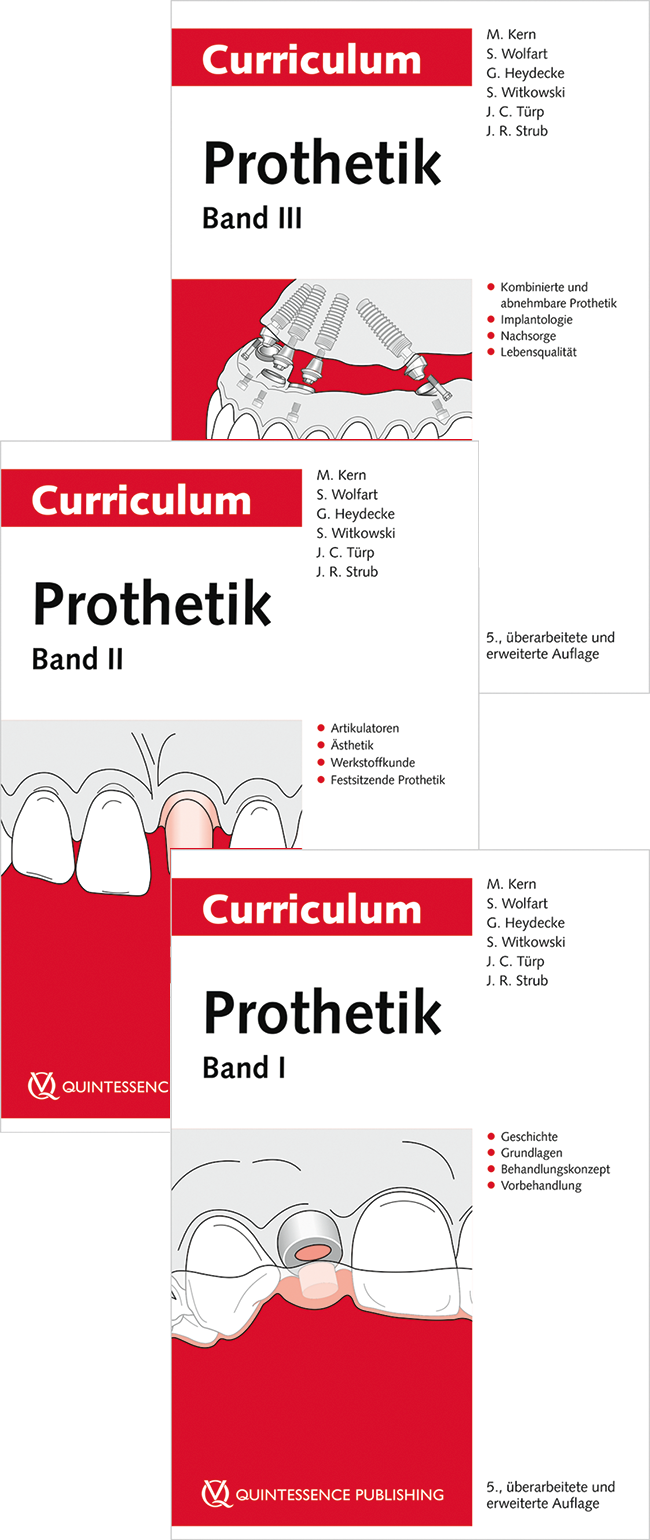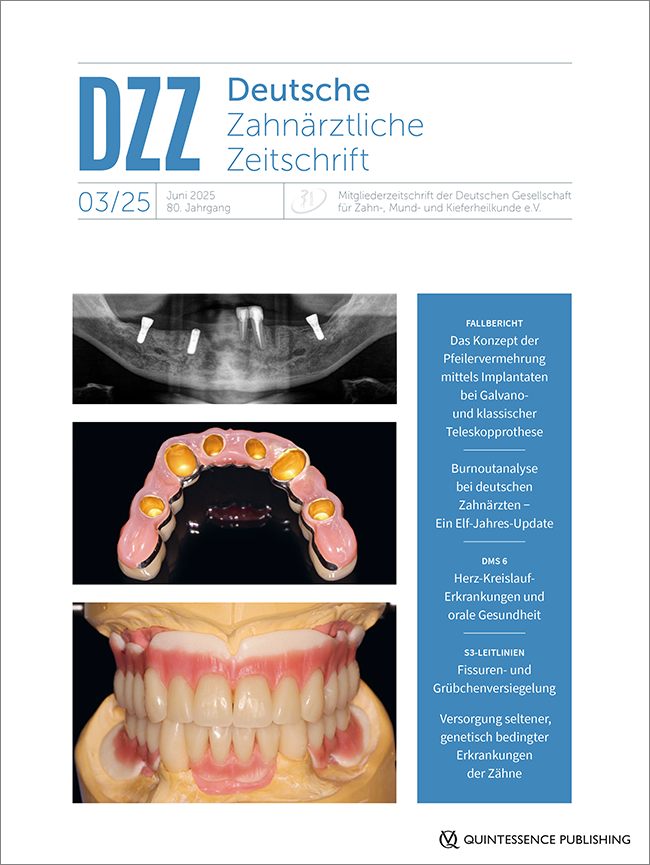Deutsche Zahnärztliche Zeitschrift, 3/2025
EditorialSeiten: 175, Sprache: DeutschGeurtsen, Werner / Heydecke, GuidoDeutsche Zahnärztliche Zeitschrift, 2/2025
EditorialSeiten: 59-60, Sprache: DeutschHeydecke, Guido / Wiltfang, Jörg / Geurtsen, Werner / Jordan, A. RainerQuintessence International, 11/2025
DOI: 10.3290/j.qi.b6044427, PubMed-ID: 40091716Seiten: S2-S3, Sprache: EnglischJordan, A. Rainer / Wiltfang, Jörg / Geurtsen, Werner / Heydecke, GuidoDMS • EditorialThe International Journal of Oral & Maxillofacial Implants, 4/2023
DOI: 10.11607/jomi.10096, PubMed-ID: 37669521Seiten: 733-738a, Sprache: EnglischPoulopoulos, Georgios / Mirzakhanian, Christine / Heydecke, Guido / Esken, Joachim / Reissmann, Daniel R.Purpose: To compare the stability of short vs standard (ie, regular-length) implants in the edentulous mandible.
Materials and Methods: In this prospective clinical study, 20 patients with edentulous mandibles received four implants each—two short implants (4 mm) in the region of the first molar and two standard implants (≥ 10 mm) in the interforaminal region. Implant stability was assessed using resonance frequency analysis immediately after implant placement and at the day of the abutment connection after 3 months of healing in order to provide an implant stability quotient (ISQ).
Results: Implant stability in the two implant groups at placement (ISQ: short 66.2; standard 68.2) and at abutment connection (ISQ: short 74.9; standard 75.7) did not differ substantially or statistically significantly (both P > .05). Findings did not change after statistically controlling for potential confounders such as bone quality and bone crest width. At abutment connection, 95% of the short and 97.5% of the standard implants demonstrated sufficient stability for conventional loading (P > .05).
Conclusions: Short dental implants demonstrate similar primary and secondary stability compared to standard implants and seem to be a promising treatment option for rehabilitation of patients with edentulous mandibles.
Schlagwörter: dental implants, short implants, implant stability, resonance frequency analysis
Deutsche Zahnärztliche Zeitschrift, 6/2022
Empfehlung der SchriftleitungSeiten: 343, Sprache: DeutschGeurtsen, Werner / Heydecke, GuidoDeutsche Zahnärztliche Zeitschrift, 6/2022
PraxisDOI: 10.53180/dzz.2022.0028Seiten: 346-352, Sprache: DeutschMirzakhanian, Christine / Esken, Joachim / Schlegel, Magdalena / Heydecke, GuidoFallberichtEinleitung: Bei der Implantattherapie des zahnlosen Unterkiefers wird die Entscheidung über die Implantatposition häufig von der Notwendigkeit eines Knochenaufbaus im Molarenbereich bestimmt. Die Knochenaugmentation erfordert einen zusätzlichen chirurgischen Eingriff und ist daher mit höheren Risiken und Kosten verbunden. Darüber hinaus sind die Modalitäten einer prothetischen Behandlung – festsitzender oder herausnehmbarer Zahnersatz – von der Implantatposition abhängig. In der Regel wird die Entscheidung zugunsten niedrigerer Kosten, geringerer Risiken und höheren Patientenkomforts getroffen, was häufig zur Wahl interforaminaler Implantate und herausnehmbarer Deckprothesen führt. Extra kurze Implantate ermöglichen festsitzende implantatgetragene Brücken im zahnlosen Unterkiefer. Außerdem ist bei Patienten mit fortgeschrittenem Knochenabbau keine komplexe Vorbehandlung mit einem Knochenaufbau erforderlich.
Material und Methoden: In diesem Fallbericht wird das Behandlungsprotokoll für eine festsitzende implantatgetragene Brücke im zahnlosen Unterkiefer anhand eines Patientenfalls beschrieben. Die Implantattherapie wurde ohne vorherige Knochenaugmentation durchgeführt. Stattdessen wurden 4 mm kurze Implantate im Molarenbereich und 10 mm lange Implantate im Eckzahnbereich mit Durchmessern von 4,1 mm inseriert. Nach gedeckter Einheilung und Freilegung der Implantate in einem zweiten chirurgischen Eingriff wurden individualisierte Titanabutments eingebracht und eine festsitzende Brücke mit einem CAD/CAM-gefertigten Gerüst und einer keramischen Vollverblendung zementiert.
Ergebnisse: Das beschriebene Behandlungsprotokoll mit Insertion von extrakurzen Implantaten im Molarenbereich und regulär langen Implantaten im Eckzahnbereich und einer festsitzenden Brücke führte zu einer vollständigen Rehabilitation der Kaufunktion im zahnlosen Unterkiefer. Aus Patientensicht ist das Behandlungsergebnis vergleichbar mit den eigenen Zähnen und führt somit zu einer Verbesserung der Lebensqualität.
Schlussfolgerung: Die Möglichkeit ohne vorherige Knochenaugmentation Implantate zu inserieren ermöglicht eine unkompliziertere Behandlung und eine deutliche Verkürzung der Behandlungszeit. Darüber hinaus kann eine Mehrzahl an Patienten mit fortgeschrittenem Knochenverlust im Molarenbereich des Unterkiefers von der vorgestellten Therapie profitieren. Aus Patientensicht führt der festsitzende Charakter des Zahnersatzes zu einer deutlichen Verbesserung der Kaufunktion und wirkt sich somit positiv aus.
Schlagwörter: festsitzende Brücke, fortgeschrittener Knochenverlust, kurze Implantate, zahnloser Unterkiefer
Deutsche Zahnärztliche Zeitschrift, 5/2022
Empfehlung der SchriftleitungSeiten: 277, Sprache: DeutschHeydecke, Guido / Geurtsen, WernerDeutsche Zahnärztliche Zeitschrift, 4/2022
ZeitschriftSeiten: 221, Sprache: DeutschGeurtsen, Werner / Heydecke, GuidoDZZ International, 3/2022
Open Access Online OnlyCase ReportDOI: 10.53180/dzz-int.2022.0011Seiten: 94, Sprache: EnglischMirzakhanian, Christine / Esken, Joachim / Schlegel, Magdalena / Heydecke, GuidoIntroduction: In implant therapy of the edentulous mandible, the decision of implant position is often determined by the need for bone augmentation in the molar region. Bone augmentation requires an extra surgery and thus presents higher risks and costs. In addition, the prosthetic treatment modality of fixed versus removable prosthesis is dependent on implant position. Usually, treatment decision is made in favor of lower costs, less risks and higher patient comfort, which often results in choosing interforaminal implants and removable overdentures. Extra short implants allow for fixed implant supported bridges in the edentulous jaw. Furthermore, in patients with advanced bone loss, pre-treatment with complex bone augmentation is not necessary.
Material & methods: This report describes the treatment protocol for a fixed implant-supported prosthesis in the edentulous mandible based on a patient case. Implant therapy was performed without bone augmentation procedures, and instead 4 mm short implants were inserted in the molar and 10 mm long implants were inserted in the canine region with diameters of 4.1 mm. After implant exposure in a second-stage surgery, a fixed prosthesis with CAD/CAM-fabricated framework and full porcelain veneer was cemented on individualized titanium abutments.
Results: The described treatment with a fixed prosthesis supported by extra short implants in the molar, and regular long implants in the canine region resulted in full rehabilitation of masticatory function in the edentulous jaw. From the patient's perspective the achieved rehabilitation is comparable to a status with own teeth and leads to an improvement in quality of life.
Conclusion: A straight forward implant placement without prior bone augmentation reduces the overall treatment time. In addition, more patients with advanced bone loss in the molar region of the lower jaw may benefit from the presented treatment protocol. From the perspective of the patient treated, the major improvement of chewing ability and the fixed character of the prosthesis made an immense positive impact.
Schlagwörter: advanced bone loss, edentulous mandible, fixed bridge, short implants
Deutsche Zahnärztliche Zeitschrift, 3/2022
ZeitschriftSeiten: 150, Sprache: DeutschGeurtsen, Werner / Heydecke, GuidoIn einer narrativen Übersicht befasst sich die Autorengruppe Roesner et al. (S. 187 und 199) mit der Epidemiologie und Diagnostik des vertikalen Zahn-hartsubstanzverlusts.
Schlagwörter: Editors' Pick







